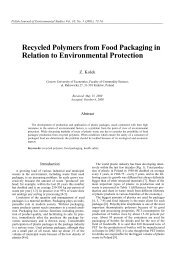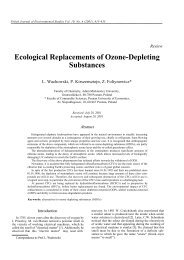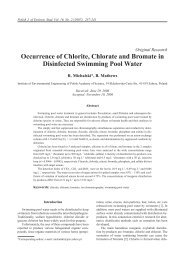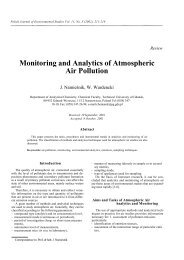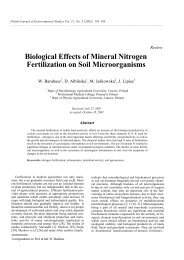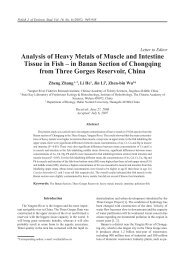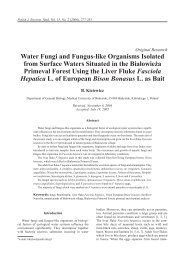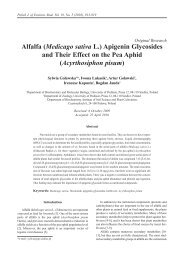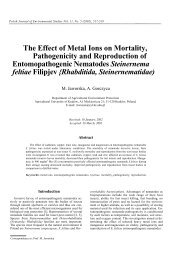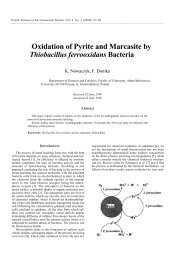Natural Radioactivity of Soil and Sediment Samples Collected from ...
Natural Radioactivity of Soil and Sediment Samples Collected from ...
Natural Radioactivity of Soil and Sediment Samples Collected from ...
You also want an ePaper? Increase the reach of your titles
YUMPU automatically turns print PDFs into web optimized ePapers that Google loves.
Polish J. <strong>of</strong> Environ. Stud. Vol. 19, No. 5 (2010), 1095-1099<br />
Short Communication<br />
<strong>Natural</strong> <strong>Radioactivity</strong> <strong>of</strong> <strong>Soil</strong> <strong>and</strong> <strong>Sediment</strong><br />
<strong>Samples</strong> <strong>Collected</strong> <strong>from</strong> Postindustrial Area<br />
Monika Śleziak, Leszek Petryka*, Marcin Zych<br />
AGH University <strong>of</strong> Science <strong>and</strong> Technology, Faculty <strong>of</strong> Physics <strong>and</strong> Applied Computer Science,<br />
Mickiewicza 30, 30-059 Kraków, Pol<strong>and</strong><br />
Received: 2 February 2010<br />
Accepted: 12 April 2010<br />
Abstract<br />
Contents <strong>of</strong> a typical postindustrial pond that was used 12 years previously as a tank for collecting waste<br />
water pumped <strong>from</strong> a coal mine was evaluated on the basis <strong>of</strong> 19 samples collected <strong>from</strong> the pond <strong>and</strong> surrounding<br />
area. Measurements <strong>of</strong> radium, thorium, <strong>and</strong> potassium, plus cesium activity, were performed with the<br />
use <strong>of</strong> a germanium detector – HPGe 4020 by examining photons with energy in the range 0.5 MeV to 3 MeV.<br />
In consequence, the concentrations <strong>of</strong> such radioisotopes as 226 Ra, 232 Th, 40 K <strong>and</strong>, 137 Cs were determined by their<br />
decay products, but the radiation effect <strong>of</strong> natural radioisotopes was estimated by I 1 <strong>and</strong> I 2 coefficients. The<br />
investigation shows the most contaminated residue in the sediments at the bottom <strong>of</strong> the settling tank.<br />
Keywords: Gamma spectrometry, Ra-226, Th-232, Cs-137, K-40, I 1 <strong>and</strong> I 2 factors<br />
Introduction<br />
One <strong>of</strong> the most important contributors to Vistula River<br />
contamination is coal mines. Salty mine water <strong>from</strong> several<br />
mines is pumped <strong>from</strong> underground <strong>and</strong> is collected in<br />
dosing tanks. Mine sewage contains a lot <strong>of</strong> coal dust, minerals,<br />
<strong>and</strong> some radioactive isotopes.<br />
The existence <strong>of</strong> radioactive elements in water provokes<br />
spreading contamination onto the surface <strong>of</strong> the<br />
ground. After settling the suspension, the partially purified<br />
water is dosed in rivers. During many years <strong>of</strong> exploitation,<br />
sediments were accumulated in a tailing pond, mostly on its<br />
bottom. These deposits include plenty <strong>of</strong> natural radioisotopes,<br />
in particular those <strong>of</strong> uranium series. Very <strong>of</strong>ten their<br />
concentration is higher than average values in this area [1].<br />
Rontok Duży pond is a reservoir with a significant sedimentation<br />
lagoon [2]. It was created in 1977 with the aim<br />
<strong>of</strong> protecting the Vistula, which is about 200 meters <strong>from</strong><br />
the pond.<br />
*e-mail: ltpetryka@gmail.com<br />
petryka@novell.ftj.agh.edu.pl<br />
The settling pond is located on the edge <strong>of</strong><br />
Oswiecimska Valley in the Silesia region, in Rudoltowice,<br />
Pol<strong>and</strong>.<br />
Exploitation <strong>of</strong> the pond lasted <strong>from</strong> 1977 to 1997. The<br />
fact that near the pond are many fields <strong>and</strong> woods raises the<br />
question <strong>of</strong> whether it is still a hazard for neighboring areas.<br />
The aim <strong>of</strong> this paper is to discuss this problem, having<br />
checked the radioactive pollution by selecting several<br />
examination points representing this area.<br />
Method <strong>of</strong> Measurement<br />
Sampling Collection<br />
The most important measurement points were chosen at<br />
the bottom <strong>of</strong> the reservoir: near the edge <strong>and</strong> in the middle<br />
<strong>of</strong> the pond. Additional soil samples were collected <strong>from</strong><br />
the neighborhood <strong>of</strong> the settling tank: northeast <strong>and</strong> northwest<br />
<strong>from</strong> the fields, below the water-supplying area <strong>of</strong> the<br />
reservoir, <strong>from</strong> the dike between the main reservoir <strong>and</strong> a<br />
buffer pond, <strong>from</strong> the western <strong>and</strong> northern parts <strong>of</strong> the
1096 Śleziak M., et al.<br />
embankment <strong>and</strong> <strong>from</strong> the woods to the north. All <strong>of</strong> them<br />
were taken <strong>from</strong> 10 centimeters depth. The samples evaluated<br />
in this paper were collected in 2007.<br />
Several samples <strong>of</strong> soil <strong>and</strong> several <strong>of</strong> sediments were<br />
taken as reference probes <strong>from</strong> an open reservoir about 10<br />
kilometers <strong>from</strong> Rontok Duży Pond.<br />
Sampling locations are marked on the map (Fig. 1).<br />
Gamma Spectrometric Measurement<br />
All samples collected in this investigation were dried<br />
for 16 hours at 105ºC <strong>and</strong> closed in aluminum containers<br />
[3-5]. We assumed that after 14 days radium <strong>and</strong> its shortlived<br />
decay products reached radioactive equilibrium. Then<br />
their activity was measured by an HPGe 4020 high-purity<br />
germanium detector constructed by Canberra. All samples<br />
<strong>of</strong> soil <strong>and</strong> sediments were prepared in the same way as the<br />
measurement.<br />
During examination, photons with energy in range <strong>from</strong><br />
0.5 MeV to 3 MeV were analyzed with 40% efficiency.<br />
The energy resolution <strong>of</strong> the detector was equal to 0.95 keV<br />
for the 122 keV peak <strong>and</strong> 1.8 keV for the 1,332 keV one.<br />
The concentration <strong>of</strong> radioactive isotopes like 226 Ra,<br />
228<br />
Th, 40 K, <strong>and</strong> 137 Cs were determined by their decay products.<br />
Radium activity was determined by 214 Bi (609.3 keV,<br />
1,120.3 keV, <strong>and</strong> 1,764.5 keV), thorium by 208 Tl (583.2 keV<br />
<strong>and</strong> 2,614.5 keV) <strong>and</strong> content <strong>of</strong> 232 Th (in secular equilibrium<br />
with 228 Th) was obtained <strong>from</strong> its decay isotopes balance.<br />
The concentration <strong>of</strong> potassium was determined <strong>from</strong><br />
its 1460.8 keV energy <strong>and</strong> cesium <strong>from</strong> 661 keV [3, 6].<br />
In all measurements, counts were collected over a period<br />
<strong>of</strong> 20 hours.<br />
I 1 <strong>and</strong> I 2 Factors Calculation<br />
Radiation effect <strong>of</strong> natural radioisotopes could be estimated<br />
by two coefficients, I 1 <strong>and</strong> I 2 , proposed by the<br />
European Commission [7]. The first one (I 1 ) determines<br />
natural isotope abundance like 40 K, 226 Ra, <strong>and</strong> 232 Th, <strong>and</strong> the<br />
second one (I 2 ) is equal to 226 Ra concentration.<br />
Fig. 1. The investigated area with location <strong>of</strong> sampling points (O – sediment; G – soil).
<strong>Natural</strong> <strong>Radioactivity</strong> <strong>of</strong> <strong>Soil</strong> <strong>and</strong> <strong>Sediment</strong> <strong>Samples</strong>... 1097<br />
The I 1 <strong>and</strong> I 2 factors are assigned by the following equations:<br />
SK<br />
I1<br />
<br />
3,000Bqkg<br />
I<br />
2<br />
<br />
S Ra<br />
1<br />
SRa<br />
<br />
300Bqkg<br />
...where: S K , S Ra , S Th are activity concentrations <strong>of</strong> 40 K, 226 Ra,<br />
<strong>and</strong> 232 Th in Bqkg -1 , respectively.<br />
Absorbed Dose Rate<br />
The measured activities <strong>of</strong> 40 K, 226 Ra, <strong>and</strong> 232 Th in soil<br />
samples were used in calculation <strong>of</strong> the gamma-absorbed<br />
dose rate in the air at 1 m over the ground. If the influence<br />
<strong>from</strong> nuclides 137 Cs or 235 U series is ignored, the following<br />
equation is obtained [8-10]:<br />
D = 0.462S Ra + 0.604S Th + 0.042S K<br />
...where:<br />
D is dose rate in μGyh -1<br />
S K , S Ra , S Th are activity concentrations <strong>of</strong> 40 K, 226 Ra, <strong>and</strong><br />
232<br />
Th in Bqkg -1 , respectively.<br />
Results <strong>and</strong> Discussion<br />
The principle result <strong>of</strong> this investigation was determination<br />
<strong>of</strong> the following radioisotope evaluations 40 K, 226 Ra,<br />
232<br />
Th, <strong>and</strong> 137 Cs. The concentration <strong>of</strong> enumerated isotopes<br />
is most important to estimate the radiation hazard <strong>of</strong> the discussed<br />
area [10]. The results <strong>of</strong> the activity measurements<br />
are shown in Table 1.<br />
The most important criterion for measuring point selection<br />
was their availability for people. All <strong>of</strong> them could be<br />
divided into two groups. Containing the radionuclides in<br />
the first one is similar to natural values <strong>of</strong> the specific activity<br />
<strong>of</strong> potassium, radium, thorium, <strong>and</strong> cesium in Pol<strong>and</strong>.<br />
The soil <strong>and</strong> sediment samples, taken near the edge <strong>of</strong> the<br />
settling pond, are ranked to this group. The activity <strong>of</strong> soil<br />
samples are between 33 <strong>and</strong> 155 Bqkg -1 for 226 Ra, 428 <strong>and</strong><br />
580 Bqkg -1 for 40 K, <strong>and</strong> 53 <strong>and</strong> 83 Bqkg -1 for 232 Th.<br />
Similarly, sediment samples are between 31 <strong>and</strong> 75 Bqkg -1<br />
for 226 Ra, 337 <strong>and</strong> 607 Bqkg -1 for 40 K, <strong>and</strong> 39 <strong>and</strong> 69 Bqkg -1<br />
for 232 Th.<br />
The results in the second group considerably exceed the<br />
natural values <strong>of</strong> the average activity in the soil <strong>of</strong> Pol<strong>and</strong>:<br />
4.2 – 116 Bqkg -1 for 226 Ra, 60 – 1,028 Bqkg -1 for 40 K, <strong>and</strong> 3.6<br />
– 82.3 Bqkg -1 for 232 Th [11, 12]. The sediment samples taken<br />
<strong>from</strong> the middle <strong>of</strong> the pond <strong>and</strong> ones taken near the edge<br />
<strong>of</strong> the pond are also classified to this group because the<br />
activity <strong>of</strong> enumerated isotopes ranged between 2,680 <strong>and</strong><br />
13,330 Bqkg -1 for 226 Ra, 249 <strong>and</strong> 504 Bqkg -1 for 40 K, <strong>and</strong> 347<br />
<strong>and</strong> 1,980 Bqkg -1 for 232 Th.<br />
The activity <strong>of</strong> any point located below the water-supplying<br />
area <strong>of</strong> the reservoir is equal to 2,260 Bqkg -1 for<br />
226<br />
Ra, 534 Bqkg -1 for 40 K, <strong>and</strong> 1,810 Bqkg -1 for 232 Th.<br />
1<br />
STh<br />
<br />
200Bqkg<br />
1<br />
Similarly, the anthropogenic 137 Cs isotope was measured.<br />
Its concentration ranged between 0.11 <strong>and</strong> 6.4 kBqm -2 for all<br />
checked samples <strong>and</strong> it is similar to the average concentration<br />
in Pol<strong>and</strong>: 0.11 – 23.68 kBqm -2 [11]. In this case the highest<br />
activity <strong>of</strong> 137 Cs was observed on the northern <strong>and</strong> northwestern<br />
parts <strong>of</strong> the embankment as a result <strong>of</strong> topography.<br />
This man-made radioactive isotope appeared in the<br />
ground after nuclear weapons tests, nuclear explosions in the<br />
stratosphere, <strong>and</strong> after the explosion <strong>of</strong> the atomic power station<br />
in Chernobyl in 1986 [8]. Those facts caused isotope 137 Cs<br />
to be included only in a thin layer <strong>of</strong> ground. The fall <strong>of</strong> the<br />
terrain promotes the rinsing out <strong>of</strong> cesium <strong>from</strong> the ground.<br />
The area surrounding Rontok Duży Pond was leveled<br />
by coal mine waste rocks. The order <strong>of</strong> Polish Ministry<br />
Board <strong>from</strong> 2007 dealing with contents <strong>of</strong> natural radioisotopes<br />
40 K, 226 Ra, <strong>and</strong> 232 Th in construction materials <strong>and</strong> in<br />
industrial wastes products used in construction gives the<br />
values <strong>of</strong> I 1 <strong>and</strong> I 2 factors. Their maximum values could not<br />
be higher than 20% <strong>of</strong> 3.5 for I 1 <strong>and</strong> 1,000 Bqkg -1 for I 2 in<br />
relation to the stripping used for leveling in unsettled areas.<br />
For those values <strong>of</strong> I 1 <strong>and</strong> I 2 the absorbed dose rate measured<br />
1 m over the ground <strong>and</strong> must be below 0.3 μGyh -1 .<br />
This condition is performed by all <strong>of</strong> the checked samples<br />
(absorbed dose rate was between 0.0662 <strong>and</strong> 0.1449 μGyh -1 ).<br />
Seven samples <strong>of</strong> soil were taken <strong>from</strong> the Rontok Duży<br />
reservoir neighborhood. The results <strong>of</strong> I 1 factor are between<br />
0.522 <strong>and</strong> 1.115, <strong>and</strong> <strong>of</strong> I 2 one between 35 <strong>and</strong> 155 Bqkg -1 .<br />
All <strong>of</strong> them are similar to those factors for the reference<br />
sample (I 1 =0.537; I 2 =33 Bqkg -1 ).<br />
Conclusions<br />
All <strong>of</strong> the soil <strong>and</strong> sediment samples were analyzed for<br />
the presence <strong>of</strong> the natural radioactive isotopes 40 K, 226 Ra,<br />
<strong>and</strong> 232 Th, as well as the anthropogenic radionuclide 137 Cs.<br />
The investigation shows that higher contamination is<br />
accumulated in the sediments at the bottom <strong>of</strong> the settling<br />
tank, especially on the intersection <strong>of</strong> inflow <strong>and</strong> outflow.<br />
The distribution <strong>of</strong> natural radioactive isotopes in adherent<br />
grounds <strong>and</strong> in sediments taken near the edge <strong>of</strong> the pond is<br />
similar to the typical values in Pol<strong>and</strong>. The maximum activity<br />
concentration <strong>of</strong> 226 Ra was equal to 13,300 Bqkg -1 <strong>and</strong><br />
1,980 Bqkg -1 for 232 Th measured near the slurry-supplying<br />
pipe <strong>of</strong> the reservoir.<br />
For all samples the calculated values <strong>of</strong> I 1 were obtained<br />
in the range 0.522 to 1.115, so below the 3.5 limit. There is<br />
no propagation <strong>of</strong> radioisotopes in the area surrounding the<br />
pond, which confirms the purposefulness <strong>of</strong> the applied<br />
ground leveling operation.<br />
Acknowledgments<br />
This work was supported by AGH UST project No.<br />
11.11.220.01 “Basic <strong>and</strong> applied research in nuclear <strong>and</strong><br />
solid state physics.”<br />
Our thanks to Paweł Jodłowski <strong>and</strong> Dariusz Dusza for<br />
cooperation in preparing the samples discussed.
1098 Śleziak M., et al.<br />
Table 1. Activity concentration <strong>of</strong> radioisotopes in soil <strong>and</strong> sediment samples collected in the neighborhood <strong>of</strong> the Rontok Duży pond.<br />
No.<br />
Locations<br />
<strong>Sediment</strong>s taken near edge <strong>of</strong> the pond<br />
Activity concentration <strong>of</strong> radionuclides [Bqkg -1 ]<br />
226<br />
Ra<br />
232<br />
Th<br />
40<br />
K<br />
137<br />
Cs<br />
O 1 drain area to the Vistula river 75±2 69±1 607±12 23.1±0.7<br />
O 2<br />
O 3<br />
west part, 100 m <strong>from</strong> the end <strong>of</strong> the dyke<br />
between main reservoir <strong>and</strong> buffer pond<br />
north part, 100 m <strong>from</strong> the dyke between main<br />
reservoir <strong>and</strong> buffer pond<br />
31±1 39±1 337±9 37.2±1.1<br />
40±1 57±1 510±10 83±2<br />
O 4 northeastern part below the dyke 31±1 53±1 461±11 27.9±0.9<br />
O 5 water supplying area <strong>of</strong> the reservoir 2260±30 1810±30 530±20 NA<br />
Kaniów pond reference sample 26±1 54±1 448±9 2.1±0.1<br />
<strong>Sediment</strong>s <strong>from</strong> the bottom<br />
O A 2690±30 1020±20 249±20 NA<br />
O B 2380±40 1170±50 251±13 NA<br />
O C 13330±160 1980±30 340±40 72±4<br />
O D 4710±60 580±10 454±11 42±1<br />
O E 2680±30 347±7 504±19 10.2±0.6<br />
<strong>Soil</strong><br />
G 1 northeast, the corn field 40±1 58±1 529±10 42±1<br />
G 2 water supplying area <strong>of</strong> the reservoir 42±1 65±1 580±11 13.1±0.4<br />
G 3 the dyke between main reservoir <strong>and</strong> buffer pond 155±2 83±1 551±9 1.8±0.2<br />
G 4 western part <strong>of</strong> embankment 37±1 54±1 491±10 6.4±0.3<br />
G 5 northwest, the field 35±1 53±1 428±10 146±4<br />
G 6 forest on the north 35±1 54±1 467±9 88±2<br />
G 7 northern part <strong>of</strong> embankment 40±1 59±1 454±10 46±1<br />
Kaniów pond reference sample 33±1 53±1 492±10 1.7±0.2<br />
Table 2. I 1 <strong>and</strong> I 2 factors in different locations in the neighborhood <strong>of</strong> the Rontok Duży pond.<br />
No.<br />
Locations<br />
I 1 <strong>and</strong> I 2 factors Absorbed Dose Rate<br />
I 1 [1] I 2 [Bqkg -1 ] D [µGyh -1 ]<br />
<strong>Soil</strong><br />
G 1 northeast, the corn field 0.600±0.008 40±1 0.0757±0.0009<br />
G 2 water supplying area <strong>of</strong> the reservoir 0.658±0.009 42±1 0.0830±0.0009<br />
G 3 the dyke between main reservoir <strong>and</strong> buffer pond 1.115±0.010 155±2 0.1449±0.0012<br />
G 4 western part <strong>of</strong> embankment 0.557±0.008 37±1 0.0703±0.0009<br />
G 5 northwest, the field 0.522±0.008 35±1 0.0662±0.0009<br />
G 6 forest on the north 0.542±0.008 35±1 0.0684±0.0008<br />
G 7 northern part <strong>of</strong> embankment 0.582±0.008 40±1 0.0732±0.0009<br />
Kaniów pond reference sample 0.537±0.008 33±1 0.0679±0.0009
<strong>Natural</strong> <strong>Radioactivity</strong> <strong>of</strong> <strong>Soil</strong> <strong>and</strong> <strong>Sediment</strong> <strong>Samples</strong>... 1099<br />
References<br />
1. AROGUNJO A.M., HOLLRIEGL V., GIUSSANI A.,<br />
LEOPOLD K., GERSTMANN U., VERONESE I., OEH U.<br />
Uranium <strong>and</strong> thorium in soils, mineral s<strong>and</strong>s, water <strong>and</strong> food<br />
samples in a tin mining area in Nigeria with elevated activity.<br />
Journal <strong>of</strong> Environmental <strong>Radioactivity</strong>. pp. 232-240,<br />
2009.<br />
2. WOŹNIAK G., COHN E.V.J. Monitoring <strong>of</strong> spontaneous<br />
vegetation dynamics on post coal mining waste sites in<br />
Upper Silesia, Pol<strong>and</strong>. Geotechnical <strong>and</strong> Environmental<br />
Aspects <strong>of</strong> Waste Disposal Sits. Sarsby & Felton eds.,<br />
London, pp. 289-294, 2007.<br />
3. KAPALA J., TOMCZAK M., ZALEWSKI M.<br />
<strong>Radioactivity</strong> <strong>of</strong> Building Materials Available in<br />
Northeastern Pol<strong>and</strong>. Polish Journal <strong>of</strong> Environmental<br />
Studies, 10, (3), 183, 2001.<br />
4. KUBICA B., MIETELSKI J.W., GOŁAŚ J., SKIBA S.,<br />
TOMANKIEWICZ E., GACA P., JASIŃSKA M., TULE-<br />
JA-KRYSA M. Concentration <strong>of</strong> 137 Cs, 40 K, 238 Pu <strong>and</strong> 239+240 Pu<br />
radionuclides <strong>and</strong> some heavy metals in soil samples <strong>from</strong><br />
two main valleys <strong>from</strong> Tatra National Park. Polish Journal <strong>of</strong><br />
Environmental Studies. 11, (5), 537, 2002.<br />
5. MIETELSKI J.W., MACHARSKI P., JASIŃSKA A.,<br />
BRODA R. Radioactive Contamination <strong>of</strong> forests in<br />
Pol<strong>and</strong>. Biological Trace Element Research, pp. 715-723,<br />
1994.<br />
6. XINWEI L. <strong>Natural</strong> radioactivity in some building materials<br />
<strong>and</strong> by – products <strong>of</strong> Shaanxi, China. Journal <strong>of</strong><br />
Radioanalytical <strong>and</strong> Nuclear Chemistry. 262, (3), 775, 2004.<br />
7. EUROPEAN COMMISSION. Radiation Protection 112:<br />
Radiological Protection Principles concerning the <strong>Natural</strong><br />
<strong>Radioactivity</strong> <strong>of</strong> Building Materials. Directorate – General<br />
Environment, Nuclear Safety <strong>and</strong> Civil Protection, 1999.<br />
8. JANKOVIĆ M., TODOROVIĆ D., SAVANOVIĆ M.,<br />
<strong>Radioactivity</strong> measurements in soil samples collected in the<br />
Republic <strong>of</strong> Srpska. Radiation Measurements, 43, 1448,<br />
2008.<br />
9. LEUNG K.C., LAU S.Y., POON C.B. Gamma radiation<br />
dose rate <strong>from</strong> radionuclides in Hong Kong soil. Journal <strong>of</strong><br />
Environmental <strong>Radioactivity</strong>. 11, 1487, 1990.<br />
10. UNSCEAR, Sources <strong>and</strong> effects <strong>of</strong> ionizing radiation.<br />
Report <strong>of</strong> the United Nations Scientific Committee on the<br />
Effects <strong>of</strong> Atomic Radiation to the General Assembly, New<br />
York, USA, 2000.<br />
11. BIERNACKA M., ISAJENKO K., LIPIŃSKI P. Monitoring<br />
<strong>of</strong> 137 Cs activity concentration in soil: years 2004-2006.<br />
Central Laboratory for Radiological Protection.<br />
Constitutional activity in year 2005 report. Warsaw, pp. 18-<br />
19, 2005.<br />
12. PAWUŁA A. On the need for use <strong>of</strong> Radiologic Criteria in<br />
Construction Site Evaluation. Symposium: Recent<br />
Engineering Geological Problems in Pol<strong>and</strong>, Instytut Geologii<br />
UAM Poznań, WIND, Wrocław, pp. 83-88, 1998 [In Polish].



